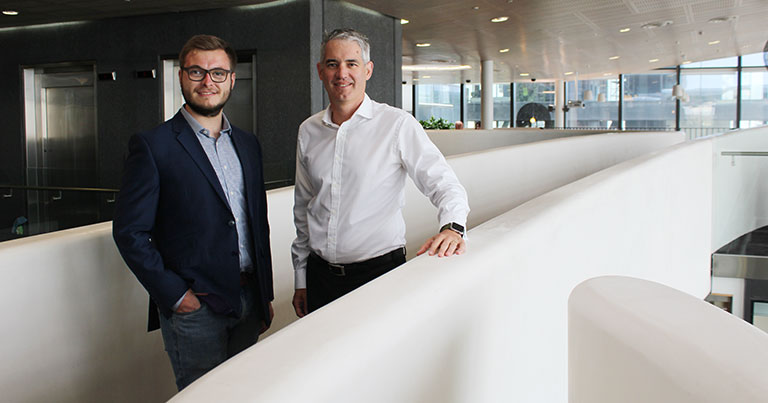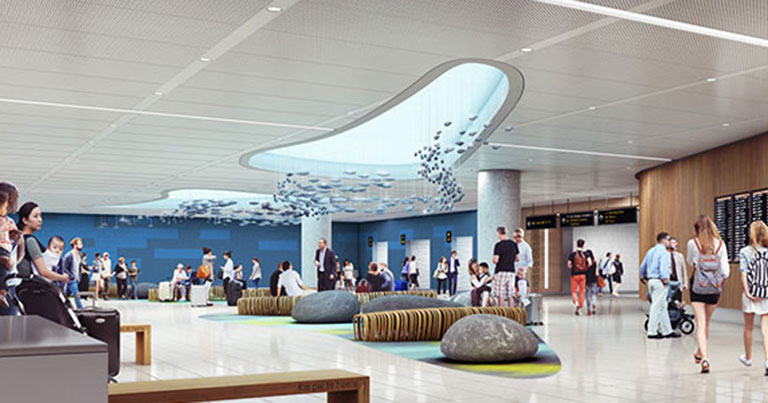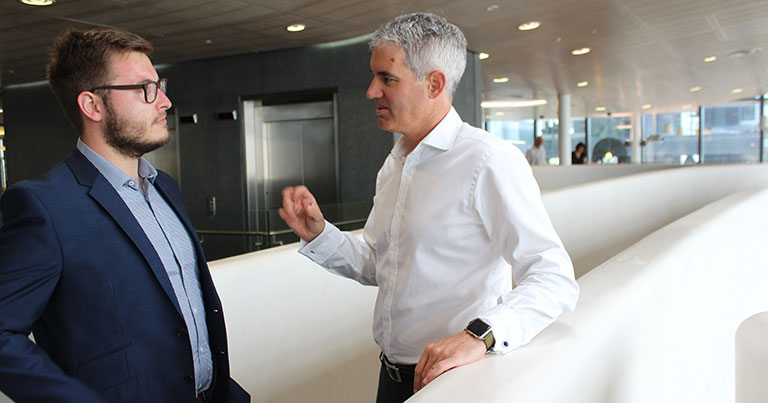Back in 2014, Auckland Airport (AKL) set out a 30-year vision for what it labelled the “airport of the future”, marking a fundamental reset of its master plan. Preparing for a twin-runway system, the strategy changed how Auckland Airport plans to utilise its terminals in the long term. At the heart of the blueprint is a proposal to create a combined domestic and international terminal in a phased approach.
FTE reporter Jonathan Ford caught up with Auckland Airport’s Chief Executive, Adrian Littlewood, to find out more about the project, including how technology will be used to elevate the passenger experience, and how the airport will reflect the best of New Zealand.

FTE: Just over a year ago construction work started on the redevelopment of the international departure area at AKL. How is this progressing and what stage have you reached to date?
AL: We are in the thick of that project now and we are starting to reach the milestones of some of our key deliveries. Around the middle of this year we will deliver phase one, which is a significant increase in the outbound processing space, and the early part of the duty free stores. Stages two and three will be delivered later this year, and then it’ll be early-2018 for the far phases, including the international terminal airside, and the other restaurant and retail shops after that. Saying that, it is a very complex project to enhance the original 1970s terminal building and, as any airport developer knows, when you start to open up those parts of the buildings, you often discover things that you didn’t even know were there.
FTE: The 30-year master plan document states that AKL aims to provide passengers with a “uniquely New Zealand experience”. How exactly do you plan to achieve this?
AL: There are a couple of components to that. The first one is the “soft” work, which is about the people. Then there is the “hard” work, which is about the function of the buildings and the way in which they operate.
So, from the people point of view, it is very much about how do we bring an authentically New Zealand experience to interactions with passengers travelling through here? I think that if there is one over-arching message that I get from people travelling through the airport, it’s a sense of welcome and a genuine desire for people to have a good experience. For instance, I know the agencies and security are specifically trained in how to welcome people with respect, rather than being very officious or formal in their engagement, as they know that they’re our first point of engagement for people arriving in New Zealand. So, I think to that collective sense as New Zealanders, we are very much in this together and we want to make sure that the experience is great.
The second part to this is the form and function of the building, and how that works. One is in terms of the design, and how we’ve incorporated cultural stories of New Zealand, the importance of Maori culture, and also the broad general New Zealand cultural identity into the building. That shows up in some simple ways in design elements such as fittings and fixtures, timber treatments, all those kinds of things, and imagery that we use to tell that story.
The last part is the food and retail outlets. They’re just as important in terms of giving that overall impression of New Zealand to the outbound traveller, as we are the first and often last place where they touch our country. We want to make sure that every part of the experience, through people, buildings and retail, picks up the best bits of New Zealand and shows them to the world.

FTE: What role will technology play in enabling you to cater to expected passenger growth and also improve the passenger experience?
AL: I, like many people, am a big believer in the great benefits of technology, both from an operating point of view and also from a customer experience point of view. And those two things are connected. From an operating point of view, we are spending a lot of money now on building the airport operating system, and this is in the context of what we call “total airport management”. Total airport management is about managing the whole system from airspace to land transport and all the parts in between, and trying to get all the companies that work in that system to try and work together in a much more coordinated and cohesive way, using technology as the core.
So, we are building an Airport Operating System platform, which allows us to draw together all those different data sources of information about the function of the airport system. We will be able to mediate that information and share it back to all the players, so we are working from a coordinated set of data, both in day-to-day operations work and also for future planning around labour management, capacity management and planning.
FTE: So how will this directly impact the passenger experience?
AL: From the customer perspective, it’s all about putting them in control and allowing the airport, airlines and agencies to deliver a more customised airport experience. That simply means, from a processing point of view, providing a more risk-adjusted or bespoke service based on your profile. It allows you to choose how you want to travel through the airport. Business travel is based on speed and convenience, a leisure traveller is more interested in exploring, discovering or shopping, while a family might just want to make the process as easy as possible. How do you put yourself in control to understand what are the queue times, what are the options or choices I have, everything from retail to hotels to parking? How do I get control of that experience?

I think airports generally are getting to the point where they’re catching up with airlines a little bit and they are realising that they do have a role to play in helping customers with their travel experience. Airlines have been very good with this, and airports are starting to play that role. After all, airlines have their infrastructure in the sky, for the passenger at least, building a great relationship with their customers. Airports, however, are a structure on the ground and they haven’t really had a deep customer relationship in the past. But certainly there is an opportunity for airports to add more to the customer’s travel experience.
FTE: Auckland Airport has previously stated that it expects to handle up to 40 million annual passengers by 2040. Just how different will the airport look come 2040?
AL: Only two years on from finalising that master plan, the growth has come on faster than we expected. So that 40-million passenger movement may come sooner than expected, but it very much depends on what happens over the next couple of decades. But what they will see is a shift away from domestic and international terminals into an integrated terminal, with a flexible footprint to accommodate a mix of passengers and fleet that we welcome into Auckland.






